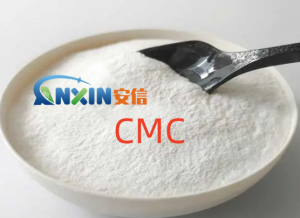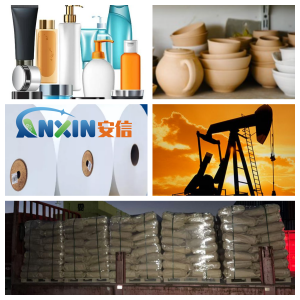Carboxymethyl cellulose (CMC) is an important cellulose ether derivative, chemically modified from natural cellulose. It exhibits excellent thickening, dispersing, stabilizing, film-forming, and water-retention properties. As a water-soluble polymer, CMC is widely used in industrial production, penetrating into numerous sectors, including food, papermaking, ceramics, oil drilling, textiles, daily chemicals, and coatings. Its stable performance, abundant resources, renewable nature, and environmental friendliness make it an indispensable multifunctional additive in modern industrial systems.
1. Basic Properties of CMC
CMC is an anionic polymer compound that is readily soluble in cold water, forming a transparent or translucent colloidal solution. Its solution viscosity can be adjusted by adjusting the degree of substitution (DS) and degree of polymerization (DP) to meet the needs of various industrial applications. CMC exhibits excellent rheological, emulsifying, suspending, and water-retention properties, significantly improving the stability and processing performance of product systems. Furthermore, CMC is biodegradable and environmentally friendly, aligning with the green and sustainable development of modern industry.
2. Major Applications of CMC in Various Industries
2.1. Papermaking Industry
CMC is a commonly used surface sizing agent, reinforcing agent, and dispersing agent in the papermaking industry. During paper production, it improves fiber bonding, enhances both dry and wet strength, and enhances printability. When used as a coating agent, CMC enhances pigment dispersion and coating smoothness, resulting in a uniform gloss and clear print quality. Furthermore, CMC reduces burrs, improves folding resistance, and enhances water resistance. It is widely used in the production of high-end paper products such as cultural paper, coated paper, and food packaging paper.
2.2. Ceramic Industry
In ceramic production, CMC is primarily used as a binder, thickener, and molding aid. It improves the plasticity and strength of ceramic bodies and prevents cracking and deformation during drying and firing. In glaze and pigment systems, CMC acts as a dispersant and rheology modifier, improving suspension properties, ensuring uniform coating adhesion, and preventing sedimentation. In particular, the use of CMC in high-end ceramic tiles and household ceramics significantly enhances surface finish and density.
2.3. Oil Drilling Industry
CMC is a key component of oil drilling fluids. It serves as a mud viscosifier, fluid loss reducer, and stabilizer, helping to adjust the viscosity and rheological properties of drilling fluids, preventing mud filtrate from entering oil and gas reservoirs and reducing formation contamination. Furthermore, CMC maintains excellent stability under high-temperature and high-salt conditions, effectively improving drilling efficiency and wellbore stability, making it an indispensable green additive in drilling fluid systems.
2.4. Textile Printing and Dyeing Industry
In the textile printing and dyeing industry, CMC primarily serves as a film-forming agent in printing pastes and slurries. It provides optimal viscosity and fluidity, ensuring uniform dye distribution, clear pattern boundaries, and vibrant print colors. Compared to traditional starch pastes, CMC has better film-forming properties, leaves less residue after peeling, and is less likely to clog printing screens. It also has excellent washability, contributing to energy-saving and environmentally friendly post-processing.
2.5. Coatings and Building Materials Industry
As a thickener and stabilizer in water-based paints and latex paints, CMC significantly improves the system’s leveling and workability, preventing pigment settling and delamination. In building mortars, putty powders, and adhesive powder systems, CMC exhibits excellent water retention and adhesion, enhancing workability and film-forming properties while reducing shrinkage and cracking. Furthermore, CMC can be used synergistically with other cellulose ethers, such as HPMC, HEC, and MHEC, to further optimize product performance.
2.6. Daily Chemicals and Food Industry
In daily chemical products, CMC is commonly used as a stabilizer and suspending agent in toothpaste, detergents, and shampoos, improving the system’s consistency and smoothness, resulting in a smooth feel. In the food industry, CMC is widely used in ice cream, beverages, jams, and pasta products as a thickener, stabilizer, and moisture-retention agent, improving taste and extending shelf life. Due to its safety, non-toxicity, and strong edibility, CMC has been approved for use as a food additive in many countries worldwide.
3. CMC Development Trends in Industry
With the advancement of fine chemicals and green manufacturing, the industrial application of CMC is moving towards high-purity, functionalized, and compounded CMC. High-purity CMC meets the needs of industries such as electronics and pharmaceuticals, which require strict control of ion content. Functionalized CMC, through the introduction of various substituents, imparts salt tolerance, heat resistance, and resistance to enzymatic degradation. Compounding technology enables CMC to synergize with other polymer additives to form a comprehensive system with enhanced performance, further expanding its industrial application.
With its excellent physicochemical properties and renewability, CMC demonstrates broad potential for industrial applications. From traditional industries such as papermaking, ceramics, and drilling to emerging fields such as environmentally friendly materials and green chemicals, CMC is playing an increasingly important role. With the advancement of process improvements and technological innovation, the industrial application of CMC will become more efficient, environmentally friendly and intelligent, providing important support for promoting sustainable industrial development.
Post time: Oct-18-2025

